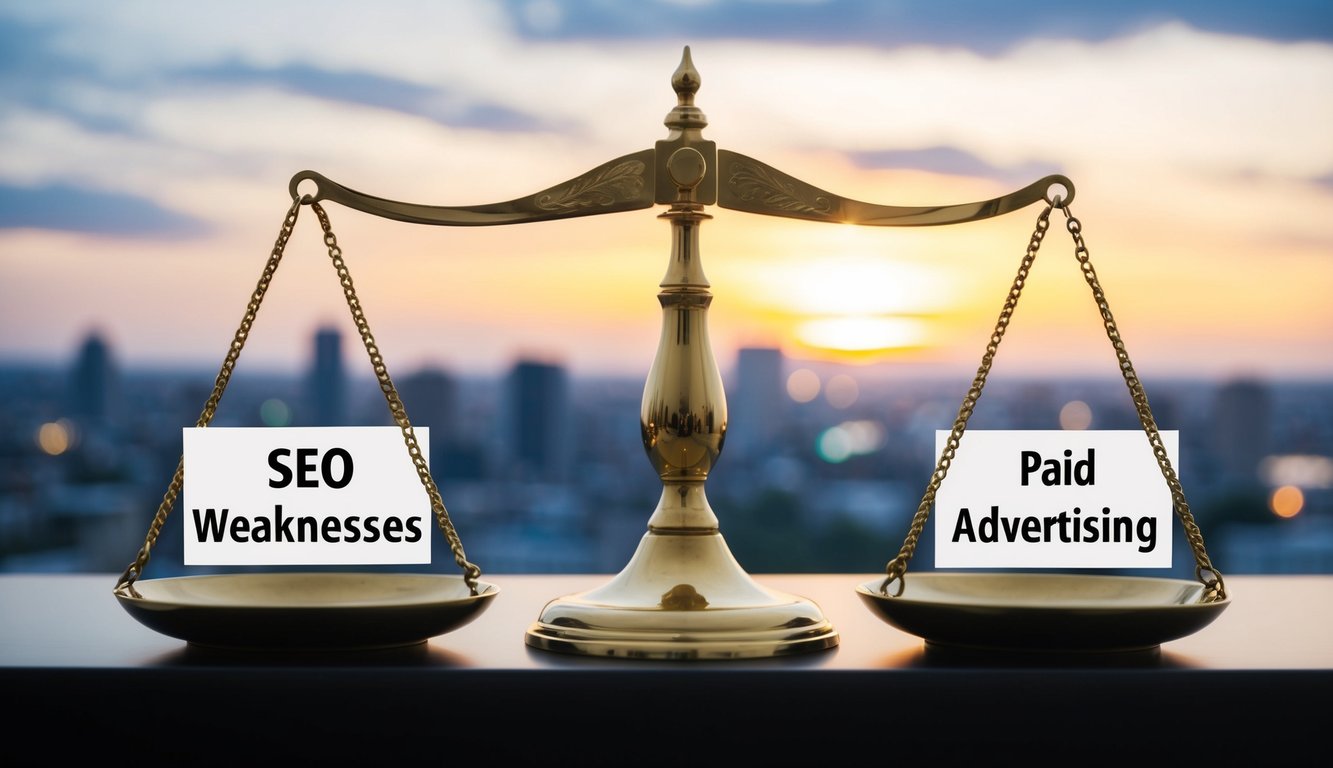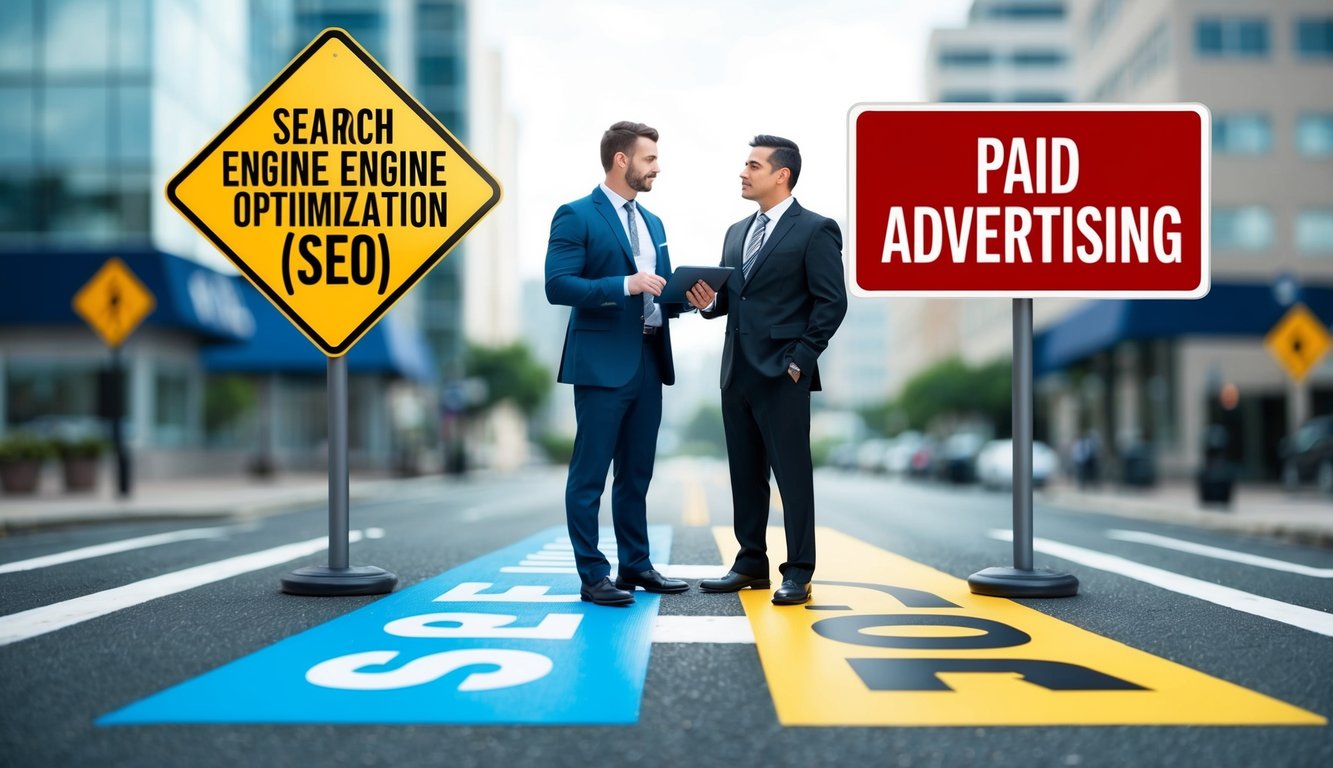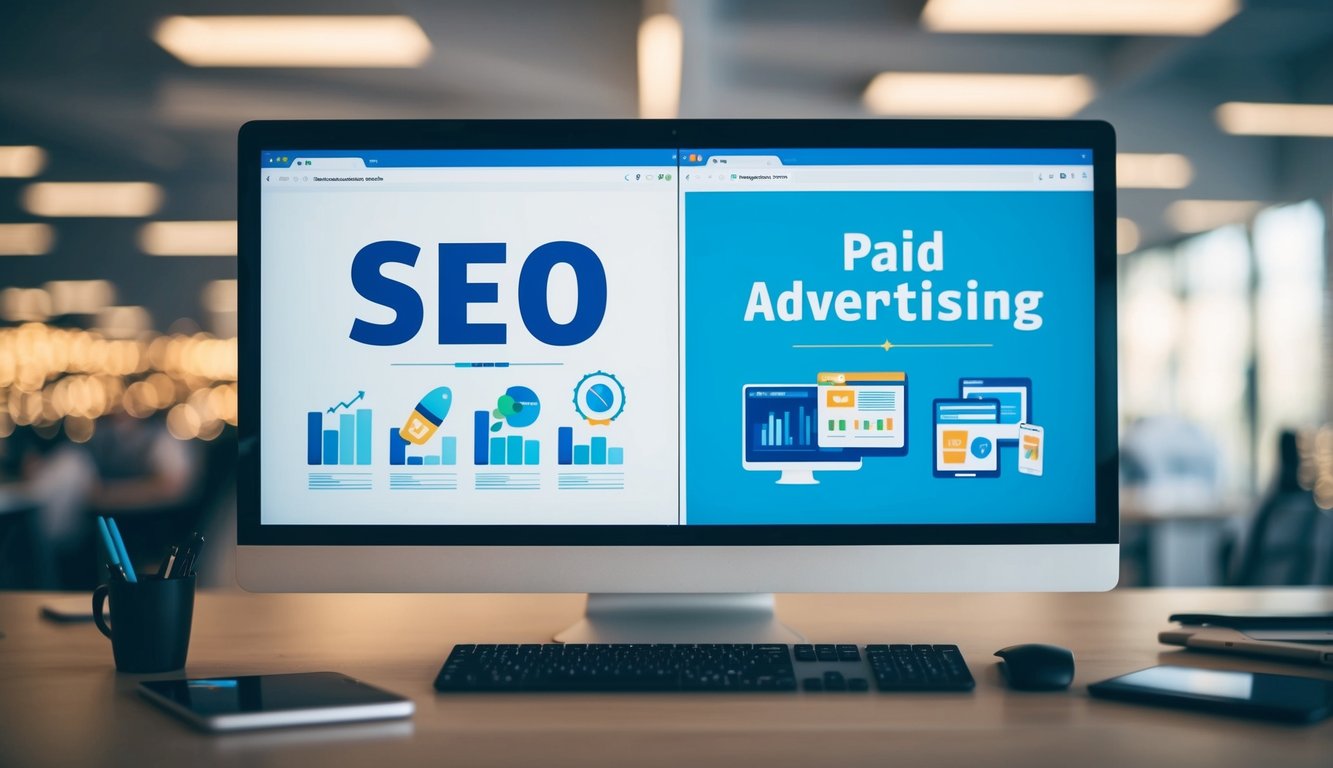The Difference Between SEO and Paid Advertising
In the ever-evolving digital landscape, you’re faced with a crucial decision: SEO or paid advertising? Both strategies aim to boost your online visibility, but they operate on vastly different principles.
Choosing the right approach can significantly impact your business’s success, driving targeted traffic and maximizing your return on investment.

SEO focuses on organic growth and long-term visibility, while paid advertising offers immediate results with a direct cost per click.
You might be wondering which strategy aligns best with your business goals and budget. The answer isn’t always straightforward, as each method has its unique strengths and challenges.
Understanding the nuances between SEO and paid advertising is crucial for making informed decisions about your digital marketing strategy.
You’ll need to consider factors like your immediate goals, available resources, and target audience to determine the most effective approach for your business.
Key Takeaways
- SEO provides long-term organic growth while paid advertising offers immediate visibility
- Your choice depends on your business goals, budget, and desired timeline for results
- Combining both strategies can create a comprehensive digital marketing approach
Understanding SEO and Paid Advertising
SEO and paid advertising are two distinct digital marketing strategies that can help your business reach potential customers online. Each approach has its own unique advantages and methods for improving your online visibility.
What is SEO?
SEO, or Search Engine Optimization, is the art of making your website more appealing to search engines like Google. It’s like giving your site a makeover to catch the eye of those picky algorithms.
The goal? To climb the ranks of search results without paying for the privilege.
SEO aims to achieve high organic rankings in the regular search results. This means when someone searches for something related to your business, your website pops up naturally, not because you paid for an ad spot.
SEO is a long-term game. You’ll need patience and persistence, but the payoff can be huge.
Think of it as planting a tree – it takes time to grow, but once it’s established, it keeps producing fruit.
Key SEO tactics include:
- Optimizing your website’s content and structure
- Building high-quality backlinks
- Improving site speed and user experience
- Creating valuable, relevant content
What is Paid Advertising?
Paid advertising is the fast lane of digital marketing. It’s like buying a first-class ticket to the top of search results or prime real estate on social media platforms. You’re essentially paying for immediate visibility and traffic.
Paid advertising allows businesses to appear at the top of search results through sponsored ads, typically marked as “Ad” or “Sponsored.” This approach can deliver quick results, making it ideal for time-sensitive campaigns or businesses looking for immediate exposure.
Common types of paid advertising include:
- Pay-Per-Click (PPC) ads on search engines
- Social media advertising
- Display ads on websites
- Retargeting campaigns
With paid ads, you have precise control over your budget, targeting, and messaging.
You can reach specific audiences based on demographics, interests, or behaviors.
It’s like having a megaphone that only the right people can hear.
Key Differences Between SEO and Paid Advertising
SEO and paid advertising are two distinct approaches to digital marketing with unique characteristics. Their differences impact cost, speed of results, longevity, and audience targeting.
Cost Implications
SEO requires a significant upfront investment of time and resources. You’ll need to create high-quality content, optimize your website, and build backlinks.
While SEO is less expensive in the long run, it demands ongoing effort to maintain rankings.
Paid advertising, on the other hand, offers a “pay to play” model. You’re charged each time someone clicks your ad.
This can add up quickly, especially in competitive industries. But you have more control over your budget and can start or stop campaigns instantly.
Want to test the waters? Paid ads let you dip your toes in without a long-term commitment.
Just remember, once you stop paying, your visibility vanishes faster than free samples at a food court.
Time to Results
Patience is a virtue, especially with SEO. It’s like planting a garden – you won’t see results overnight. Expect to wait 3-6 months before seeing significant improvements in your organic rankings.
Paid advertising is the sprinter of digital marketing.
Launch a campaign, and boom! Your ads appear at the top of search results faster than you can say “instant gratification.”
PPC lets you reach customers immediately, perfect for time-sensitive promotions or quick traffic boosts.
Sustainability and Long-term Impact
SEO is the marathon runner of digital marketing strategies. Once you achieve good rankings, they tend to stick around. Your organic traffic becomes a steady stream, flowing even when you’re not actively working on it.
• Builds trust and credibility
• Compounds over time
• Provides consistent traffic
Paid advertising is more like a sugar rush. It delivers quick results but fades just as fast when you stop feeding it money. Your visibility disappears the moment you pause your campaigns.
Targeting and Reach
SEO casts a wide net, attracting users who are actively searching for your products or services. It’s great for building brand awareness and capturing organic traffic across various search intents.
Paid advertising offers laser-focused targeting options:
- Demographics
- Interests
- Behaviors
- Geographic locations
You can customize your PPC campaigns to reach specific audience segments with pinpoint accuracy. This precision targeting is perfect when you know exactly who your ideal customer is and where to find them.
Strengths and Weaknesses of SEO

SEO can be a game-changer for your online presence, but it’s not without its challenges. Let’s dive into the nitty-gritty of what makes SEO shine and where it might leave you scratching your head.
Benefits of SEO
You’ve hit the jackpot with SEO when it comes to building credibility through organic rankings. Your website climbs the search engine ladder, earning trust from users who prefer organic results over paid ads.
Cost-effectiveness is your new best friend. Once you’ve invested in solid SEO practices, you’ll enjoy long-term visibility without the constant drain on your wallet that paid ads can be.
Traffic quality? Top-notch. SEO brings in users actively searching for what you offer, increasing the chances of conversion.
• Improved user experience
• Higher ROI in the long run
• Increased brand awareness
Challenges of SEO
Don’t pop the champagne just yet. SEO isn’t all sunshine and rainbows.
It’s a long-term game that requires patience. You won’t see results overnight, and that can be frustrating when you’re itching for immediate impact.
The SEO landscape is as unpredictable as a cat’s mood. Algorithm changes can send you back to square one faster than you can say “Google update.”
• Time-consuming process
• Requires continuous effort and adaptation
• Results are not guaranteed
You’ll need to stay on your toes, constantly updating your content and strategies. It’s not a set-it-and-forget-it solution, but rather an ongoing commitment to staying relevant and valuable in the eyes of search engines and users alike.
Strengths and Weaknesses of Paid Advertising
Paid advertising offers a mixed bag of rapid results and potential pitfalls. You’ll need to weigh the pros and cons carefully before diving in.
Benefits of Paid Advertising
Instant results are the name of the game with paid ads. You hit that launch button, and bam! Your ads are out there, grabbing eyeballs faster than you can say “ROI.”
Precision targeting is another feather in paid advertising’s cap. Want to reach left-handed ukulele players in Timbuktu? There’s an ad setting for that.
Control freaks, rejoice! With paid ads, you’re the puppet master. You decide when your ads show up, who sees them, and how much you’re willing to shell out.
Data junkies will love the treasure trove of insights paid advertising provides. You’ll know exactly what’s working and what’s not, faster than you can say “analytics.”
Challenges of Paid Advertising
Hold onto your wallet – paid advertising can drain your resources faster than a leaky faucet if you’re not careful. Each click comes with a price tag, and those costs can add up quicker than you’d think.
Ad fatigue is real, folks. Your audience might start tuning out your ads faster than a boring infomercial if you don’t keep things fresh.
The learning curve can be steeper than Mount Everest. Between bid strategies, ad formats, and platform quirks, you might feel like you need a Ph.D. in digital marketing.
Competition is fierce in the paid ad arena. You’re not just competing for attention; you’re battling for ad space and keywords. It’s like the Hunger Games, but with a bigger budget.
Choosing the Right Strategy for Your Business

Selecting between SEO and paid advertising isn’t a one-size-fits-all decision. Your choice can make or break your digital marketing efforts, so you’ll want to consider several key factors carefully.
Assessing Your Business Goals
Are you aiming for world domination or just trying to get your mom to visit your website? Your goals will steer your strategy.
Short-term objectives? Paid advertising might be your golden ticket. It’s like buying a first-class ticket to the top of search results.
Looking for long-term brand building? SEO is your slow and steady race winner. It’s the tortoise to paid advertising’s hare.
Consider these questions:
- Do you need immediate visibility?
- Are you building a lasting online presence?
- Is your product seasonal or evergreen?
Your answers will help you decide which path to take.
Remember, you can always mix and match strategies as your business evolves.
Budget Considerations
Money talks, but in digital marketing, it whispers sweet nothings to search engines.
SEO is like planting a garden. It requires an upfront investment of time and resources, but once it blooms, you’ll reap the benefits for years.
Paid advertising, on the other hand, is like renting a billboard. The moment you stop paying, your visibility vanishes faster than free samples at Costco.
Each organic click from SEO can offer a higher profit margin than a paid ad click. But don’t forget, quality SEO isn’t free – it requires ongoing investment in content and optimization.
Consider your budget’s staying power:
- Can you afford consistent ad spend?
- Do you have resources for long-term SEO efforts?
- What’s your tolerance for fluctuating costs?
Timeline and Urgency
Time is money, and in digital marketing, it’s also traffic and conversions.
SEO is a marathon. You’re in it for the long haul, building authority and climbing rankings over months or even years. It’s perfect if you’re patient and looking for sustainable growth.
Paid advertising is your sprint to the finish line. Need results yesterday? PPC can deliver traffic faster than you can say “Google Analytics.”
Ask yourself:
- How soon do you need results?
- Can you wait for organic growth?
- Is your business seasonal or time-sensitive?
Use paid ads for immediate visibility and quick lead capture, but don’t neglect SEO for long-term success.
Industry and Competition
Your industry isn’t just a label – it’s your digital battleground. Know your enemies (competitors) and your weapons (keywords).
In highly competitive niches, SEO can be as challenging as teaching a cat to bark. You might need deep pockets and endless patience to see results.
Paid advertising can give you a shortcut to visibility, even in crowded markets. But be prepared for high costs per click in competitive industries.
Consider these factors:
- How saturated is your market?
- What strategies are your competitors using?
- Are there untapped keyword opportunities?
Sometimes the best strategy is to zag when others zig. Look for gaps in your competitors’ approaches and pounce on those opportunities.
Combining SEO and Paid Advertising

Integrating SEO and paid advertising creates a powerful digital marketing strategy. You’ll benefit from both immediate visibility and long-term organic growth.
Benefits of an Integrated Approach
By combining SEO and paid ads, you’re getting the best of both worlds. Your paid ads provide instant visibility while your SEO efforts build lasting organic rankings. This synergistic effect maximizes your online presence.
Paid ads can help you test keywords before investing in SEO. You’ll quickly see which terms convert best, informing your long-term strategy. Plus, you’ll dominate search results pages, appearing in both paid and organic listings.
Data from paid campaigns can supercharge your SEO efforts. You’ll gain valuable insights into user behavior, helping you optimize your content and site structure. Talk about a win-win situation!
Case Studies of Successful Integration
Let’s look at some real-world examples of businesses crushing it with integrated strategies.
Company X increased their conversions by 150% after aligning their PPC and SEO efforts. They used paid ads to test messaging, then applied those insights to their organic content.
Another brand saw a 200% increase in organic traffic after using paid ads to boost their initial visibility. The increased engagement signals helped their SEO rankings soar. Who doesn’t love a good underdog story?
E-commerce giant Y reduced their cost per acquisition by 30% through smart integration. They used SEO to target informational queries and paid ads for transactional ones. Now that’s what we call playing to your strengths!
Conclusion

Choosing between SEO and paid advertising isn’t a one-size-fits-all decision. Your business goals, budget, and timeline all play crucial roles in determining the right strategy.
SEO offers long-term benefits and credibility, but requires patience and consistent effort. It’s like planting a garden – you’ll reap the rewards, but not overnight.
Paid advertising, on the other hand, is your express ticket to visibility. It’s perfect when you need quick results or want to target specific audiences. But remember, once you stop paying, the traffic stops flowing.
The smart move? Combine both approaches. Use paid ads for immediate impact while nurturing your SEO strategy for lasting success. It’s like having your cake and eating it too – who doesn’t want that?
Remember to regularly monitor and adjust your strategies. The digital landscape changes faster than fashion trends, so stay on your toes.
Ultimately, the best choice is the one that aligns with your business objectives. So, take a good look at your goals, resources, and timeline. Then make your move. Your future customers are waiting!